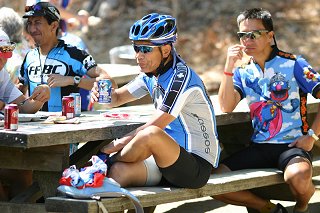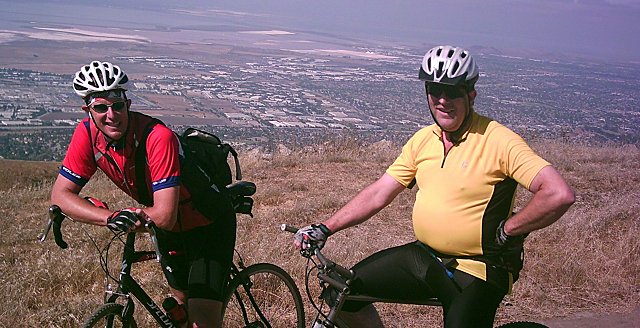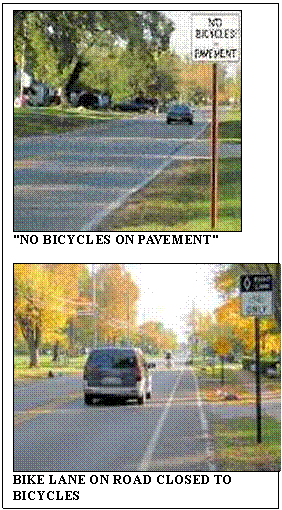
|
SPECIAL HAPPENINGS For more photographs by Murat Alaybeyi, please visit: http://alaybeyi.smugmug.com/gallery/3490217#196616903
Bicycle Blunders and Smarter Solutions (continuing article submitted by Wynn Kageyama) 6. Blunders in Traffic Law and Enforcement What's Wrong With Bicycle Traffic Laws?
Many governments at the state and local level treat cyclists as incompetent children or third-class citizens. Some forbid cycling on roadways, but instead direct cyclists to use more dangerous facilities such as sidewalks and pathways beside the road. Other directives confine cyclists to the edge of the road, even where the road edge may not be safe. In many states, local ordinances form a crazy-quilt of dangerous and discriminatory rules that vary from community to community and that conflict with rules followed by other drivers [1]. Update: Major state law reforms sponsored by the Ohio Bicycle Federation were passed into law in 2006. The most important of these reforms finally provides uniformity of Ohio bicycle traffic laws. The Avon Lake "bike ban" is now illegal [1]. The safest way to operate a bicycle is as the lawful driver of a vehicle. This means riding on the roadway following the same traffic rules as other drivers. The general traffic laws support what we call "Vehicular Cycling". Cyclists who operate this way have one-fifth the crash rate of the average. Paradoxically, the best and safest practices are sometimes prohibited while dangerous mistakes of novices are encouraged by special bicycle-specific laws. Why are traffic laws important to cyclists?The safety and mobility of cyclists depends on equitable traffic law.Traffic laws influence:
Categories of Bicycle Traffic Law Defects
Examples of Serious Bicycle Traffic Law Defects
Enforcement Problems and Behavior of Public OfficialsCorrect enforcement of traffic law is as important as having good laws. This means the police must be properly trained in bicycle operation and they must understand bicycle traffic laws. Misinformed police often make errors of omission by ignoring illegal practices that lead to crashes. They occasionally make errors of commission by harassing lawful cyclists for riding in ways that they think are dangerous but that are actually safe and legal. Too often, police fail to take seriously road rage and other types of harassment directed at cyclists. A mis-trained officer can spoil your day. All of society suffers when a cyclist is unjustly cited for riding lawfully. Police, prosecutors and judges have their attention diverted from what they should be doing. But the cyclist suffers most because, even if he beats the rap, he will not be made whole for either legal expense or the aggravation suffered.
Fortunately, the judge did not agree. About Helmet Laws and Bicycle Registration One of the most contentious issues cyclists face is the promotion of laws that would require persons operating bicycles to wear helmets. Helmet laws are promoted by well-meaning public health advocates who know little of cycling and by not-so-well-meaning insurance companies looking for an excuse to deny compensation to victims. This author believes that a helmet can reduce injury from a crash and therefore, always wears one. However, promoting helmet use as the primary (or the only) safety measure amounts to advocating safe crashing. Not crashing is much more important. We must teach people how to ride safely. Helmet laws are government interference in the private affairs of citizens. In most cases the government officials know little about cycling. Ironicly, helmet laws can actually make safety problems worse by creating a perception that the problem is solved - when it truly isn't. Some communities offer a registration program to deter theft and aid recovery of stolen bicycles. Any registration program must be voluntary. If police make a serious effort to return stolen bicycles, then a program can be valuable. However, there have been cases where mandatory bicycle registration has become a "tool" for harassing lawful cyclists. [1] This author surveyed and rated the local bicycle traffic ordinances for 65 NE Ohio Communities. About half of the communities included ordinances that mandate one or more dangerous practices (some corrected after notification). A large part of this problem is due to Ohio law that allowed local authorities authority for regulating the operation of bicycles. A new law passed in 2006 will correct this problem -- no such regulation shall be fundamentally inconsistent with the uniform rules of the road prescribed by this chapter and that no such regulation shall prohibit the use of bicycles on any public street or highway ... Please join us and help restore the BikeLeague to members. © Copyright 2004-2007 Fred Oswald. May be copied with attribution. Some materials may have been reproduced under fair use guidelines or with permission of the original author. The author is a Professional Engineer in Ohio and a certified League Cycling Instructor. Last Revised 5/5/07 |
||||||





 Motor vehicle traffic laws are generally uniform throughout the 50 states. A driver traveling from state to state need not learn a new set of laws with each border crossing. Likewise, within each state, local authorities have only limited powers to enact local ordinances. The basic set of the "rules of the road" is fairly consistent throughout the country.
Motor vehicle traffic laws are generally uniform throughout the 50 states. A driver traveling from state to state need not learn a new set of laws with each border crossing. Likewise, within each state, local authorities have only limited powers to enact local ordinances. The basic set of the "rules of the road" is fairly consistent throughout the country.